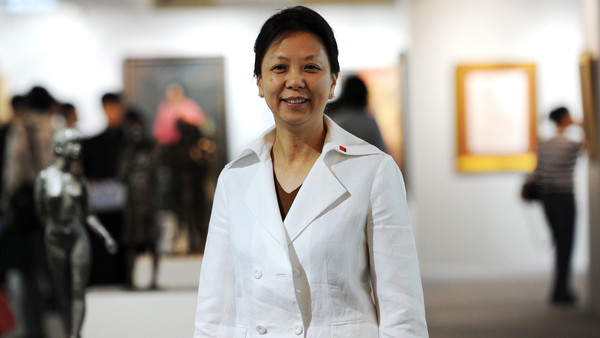Wang Yannan: Daughter of the revolution takes on C
Post# of 456
High quality global journalism requires investment. Please share this article with others using the link below, do not cut & paste the article. See our Ts&Cs and Copyright Policy for more detail. Email ftsales.support@ft.com to buy additional rights. http://www.ft.com/cms/s/0/d3b9d4e2-2f38-11e3-...z2lkrGHmoW
When Wang Yannan was growing up during the Cultural Revolution in China , the daughter of former Chinese leader Zhao Ziyang never imagined that one day she would run the fourth-largest auction house in the world.
Speaking in Hong Kong where China Guardian over the weekend sold HK$510m (US$66m) in Chinese art and ceramics, Ms Wang recalls how a family friend whose husband had been jailed struggled to destroy paintings to prevent more problems with the Red Guards.
ON THIS STORY
- Christie’s confident over China auction
- Chinese contenders pose challenges
- Chinese auction houses go global
- beyondbrics China art market – auction houses see slump in 2012 sales
- Zeng Fanzhi A wealth of art in China
ON THIS TOPIC
- China’s public sector seeks security help
- China population suffers gender imbalance
- Data clash with China baby boom fears
- China rethink marks symbolic shift
IN CHINA
- Q&A What are China and Japan arguing over?
- Japan anger at China air zone
- Sinopec apologises for oil explosion
- Derision for China’s ‘rejuvenation index’
“Chinese paintings are quite tough to destroy. You cannot burn it, because once you burn, the Red Guards can smell the smoke,” Ms Wang explains. “She soaked [each one] in a bath basin and tried to tear it, but?.?.?.?the silk had good starch. It took her quite an effort to destroy these things, piece by piece, and flush [down] the toilet.”
In the years since the violent decade of anarchy unleashed by Mao Zedong in 1966, Ms Wang has moved a long way from a world where art was not taught in school and from a feeling that “these things [art] can only bring you trouble”.
In 1993, she co-founded China Guardian after her partner dismissed her concerns about a lack of training and experience. “In China, nobody had any experience,” she explains. “We didn’t even know [about] Sotheby’s and Christie’s .”
China Guardian is now the world’s fourth biggest auction house, after Sotheby’s, Christie’s and Beijing Poly International , a younger Chinese rival. And art that might have destroyed lives during the Cultural Revolution is now desperately sought by Chinese collectors and investors. CLSA estimates that the Chinese art market has grown from $1.5bn in 2008 to $5.1bn last year.
When China Guardian held its first auction in Hong Kong in 2012, the sale brought in $67m, more than half the amount that Christie’s generated from sales of Chinese art and ceramics at its autumn Hong Kong event.
Even before China Guardian knew the final results of its weekend Hong Kong auction, its third in the city – which coincided with sales by Sotheby’s and Poly – Ms Wang said the results were “way beyond our expectations”, including the $5.4m sale of a piece of calligraphy by Song Lizong, a 13th century Song dynasty emperor.
While China Guardian and Poly are making inroads in Hong Kong, some experts say they do not pose a serious challenge to the international houses yet. Brian Wallace, founder of the Red Gate Gallery in Beijing, says they need to put in a “couple of years of legwork” first, but adds that they would be able to use their mainland contacts to bring more Chinese works to auction in Hong Kong.
Chinese paintings are quite tough to destroy. You cannot burn it, because once you burn, the Red Guards can smell the smoke
- Wang Yannan
Ms Wang says China Guardian wants to “step out in Hong Kong” to reach more potential buyers. She says the Chinese territory has “more energy, because it has clients not only from greater China, but also from Taiwan, Singapore, Indonesia and also from?.?.?.?Europe and the States.”
But asked if she plans to take the company further afield, she responds: “It took us 20 years to step out to Hong Kong. I think we probably have enough to work with now with Hong Kong and Beijing.”
Speaking in excellent English – learnt in college in Guangdong at the end of the Cultural Revolution and in Hawaii where she studied hotel management – she demurs over the question whether China Guardian poses a threat to Sotheby’s and Christie’s: “I think the market is big enough and everyone has his own strength.”
China Guardian’s rise has shone attention on Ms Wang and her background as a “princeling” – the term given to relatives of senior party members. When she worked at the Sheraton after returning from the US, she says nobody knew who she was.
“I don’t feel that someone should live in the shadow of their family, for good or for bad. I should have my own credit, my own identity.”
But when people found out that her father was Zhao Ziyang , they would become very polite: “Mostly they would say, they respect my father and I appreciate that.”
Zhao served as premier and then general secretary of the Communist party, before he was purged after the 1989 Tiananmen Square massacre for being too soft. In his last public appearance, Zhao told the protesters in the square: “I came too late”.
Ms Wang says her father showed no interest in art – “he was just work, work, work” – but neither did he discourage her from the career path she took.
“He let me make my own choices?.?.?.?It was quite diplomatic in our home around the dining table,” she says. “I cannot remember him ever asking me to work hard, or to do something, or to join the party, or to join the youth league. He never did.”
Additional reporting by Julie Zhu
 (0)
(0) (0)
(0)